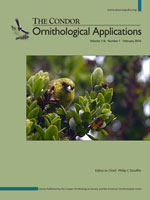Many migratory bird species, including the American Black Duck (Anas rubripes; hereafter black duck), face challenges to their survival during winter due to potentially limited resources and high energetic demands. These winter processes can be especially important for the population dynamics of migratory species. Despite stabilization of the overall black duck breeding population, historical declines continue for black ducks wintering in the Mississippi Flyway. It remains unclear if declining abundance in this region reflects high winter mortality. We radio-tagged 111 females in the Tennessee National Wildlife Refuge (TNWR), a major wintering area for mid-continent Mississippi Flyway black ducks, from December to February of 2010–2012 to estimate winter survival and investigate factors that may influence survival rates, including body mass, age, hunting period, and weather. Winter survival (0.83–0.85) was greater than or comparable with previous estimates for black duck populations in North America. Generally, birds with greater body mass had higher survival than birds of lesser body mass; a bird 100 g heavier than one of average body mass had 18% greater interval survival. We also found that body mass had a greater influence on survival during late (nonhunting) periods and a more severe winter, when resources potentially were limited. For example, a bird with a body mass 100 g above average had 9% greater interval survival than one of average body mass during the winter of 2010–2011, but in the subsequent milder winter, the heavier bird had similar survival to the bird of average body mass. Our results suggest that winter mortality is not a primary factor contributing to declining abundance of black ducks in the TNWR. If this reflects the general pattern in the Mississippi Flyway, declining regional abundance may be driven by movement patterns or cross-seasonal effects rather than winter mortality.
How to translate text using browser tools
11 November 2015
Winter survival of female American Black Ducks in Tennessee, USA
Kira C. Newcomb,
J. Brian Davis,
Richard M. Kaminski,
Matthew J. Gray
ACCESS THE FULL ARTICLE

The Condor
Vol. 118 • No. 1
February 2016
Vol. 118 • No. 1
February 2016
American Black Duck
body mass
hunting
known-fate models
Mississippi Flyway
weather
winter




